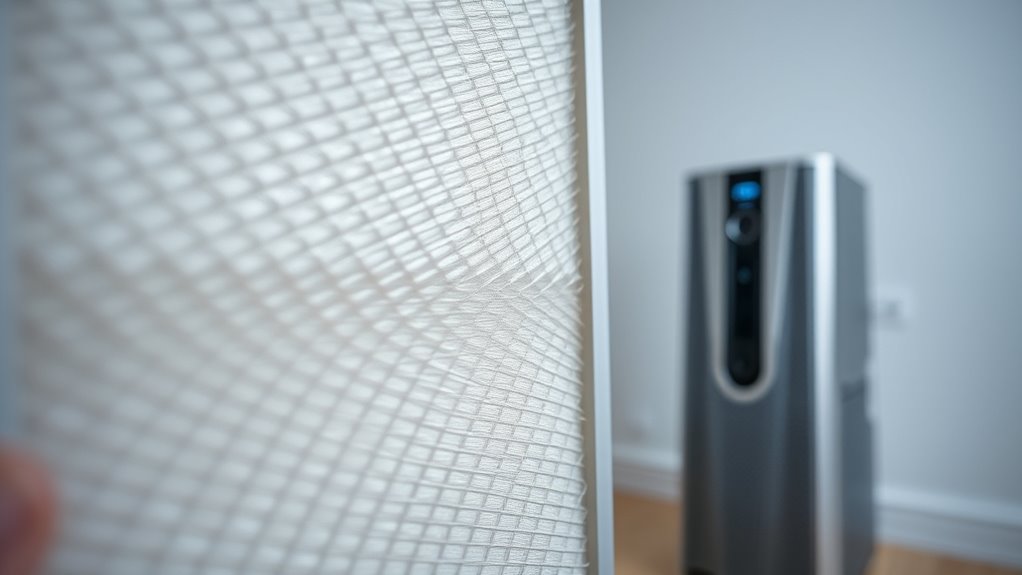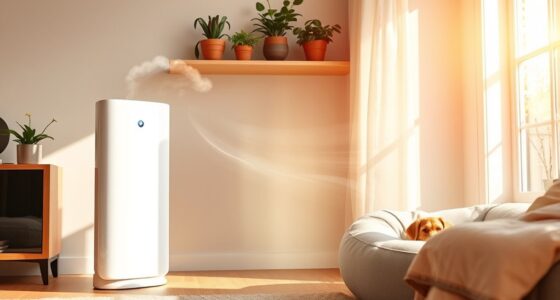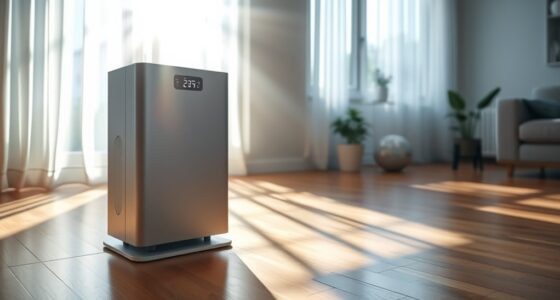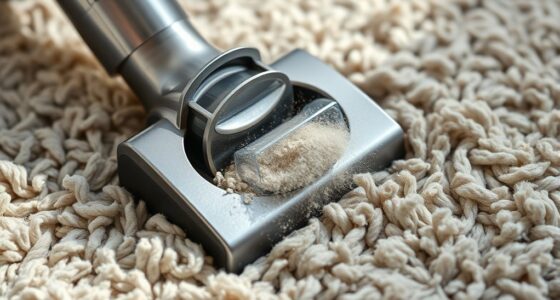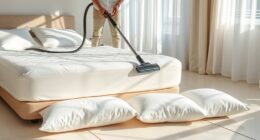HEPA filters are designed to capture at least 99.97% of airborne particles, improving your indoor air quality considerably. They use various mechanisms like impaction and interception to trap allergens, dust, and even some bacteria. This technology evolved during the 1940s and has advanced with innovations like HEPA 14 filters, which capture even smaller particles. Regular maintenance is essential for peak performance, so you’ll want to keep that in mind as you explore the fascinating details of HEPA filtration.
Key Takeaways
- HEPA filters capture at least 99.97% of particles 0.3 micrometers or larger, ensuring high air purification efficiency.
- Their unique structure employs mechanisms like impaction, sieving, and interception to trap airborne contaminants.
- Regular maintenance, including filter replacement, is crucial to maintain optimal air purification performance.
- Advanced HEPA variants, like HEPA 14, enhance filtration by capturing even smaller particles at 99.995% efficiency.
- Smart technology integration allows for real-time monitoring of air quality, improving overall indoor environments.
Understanding HEPA Filter Basics
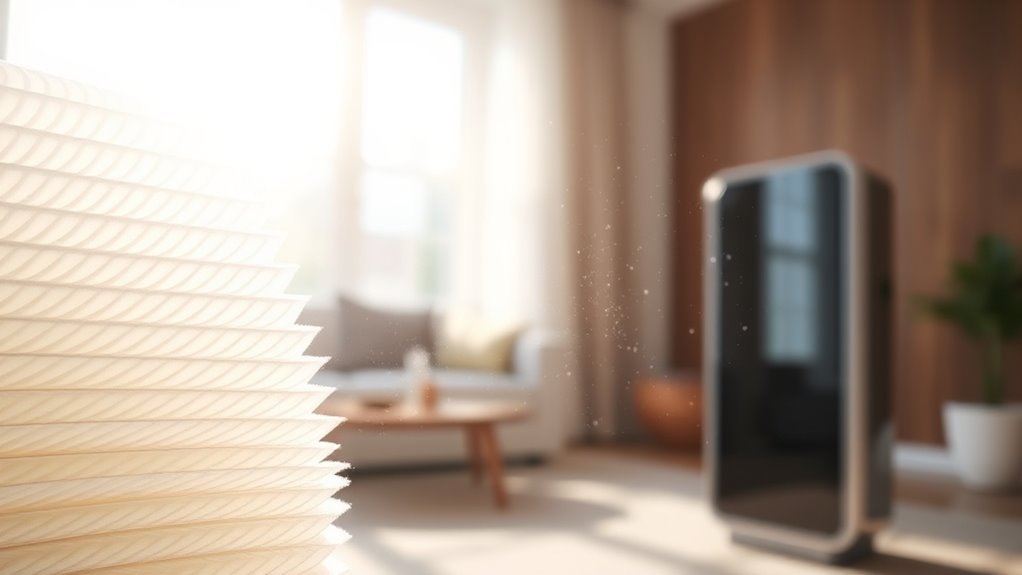
HEPA filters play an essential role in maintaining clean indoor air. These High Efficiency Particulate Air filters must capture at least 99.97% of particles that are 0.3 micrometers in size or larger.
You’ll find HEPA air filters in homes, hospitals, and laboratories, valued for their effectiveness in improving indoor air quality by removing allergens and pollutants. Many models utilize HEPA filtration technology to ensure optimal performance. Additionally, regular filter replacement is recommended to maintain their efficiency over time. The growing demand for air purifiers highlights the importance of these filters in consumer health. Regular use can lead to improved respiratory health, especially for those with allergies.
The unique structure of these filters, made of tangled fibers, utilizes several mechanisms—impaction, sieving, interception, and diffusion—to trap airborne particulate matter.
While HEPA filters greatly enhance air quality, they aren’t flawless; they can miss some smaller particles like PM2.5, which are less than 0.3 micrometers. Regular cleaning processes can ensure that the HEPA filters continue to perform effectively in trapping airborne particles.
Understanding these basics helps you appreciate the importance of HEPA filters in effective air purifiers.
The Evolution of HEPA Filter Technology
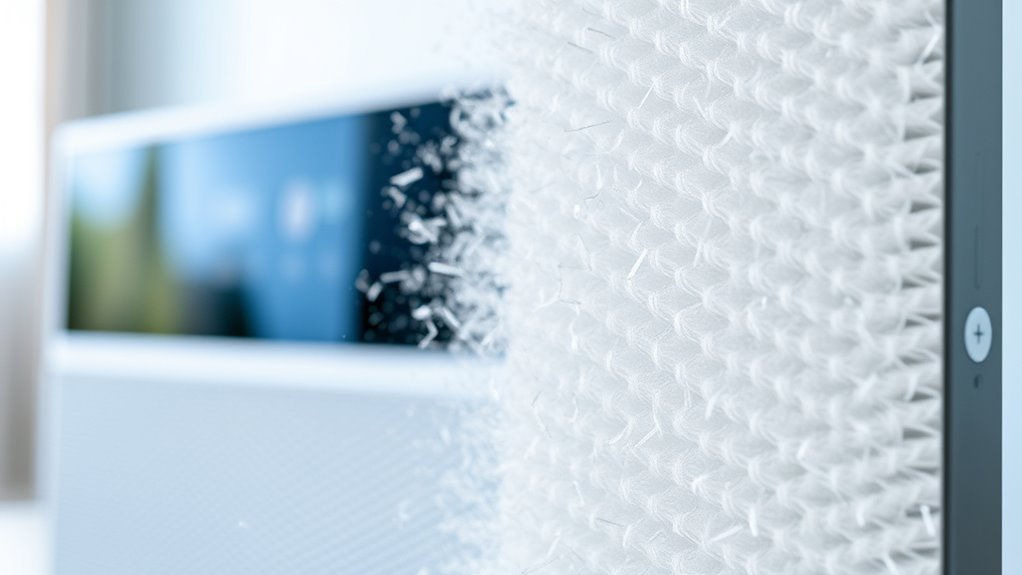
You might be surprised to learn that HEPA filters originated during the 1940s as a safeguard against radioactive particles in the Manhattan Project. Since then, their evolution has led to significant advancements in filtration techniques, making them essential in various settings, from homes to hospitals. Let’s explore how this technology has transformed over the decades and what innovations have shaped its efficiency today. Recent developments in air quality improvement have highlighted the importance of HEPA filters in reducing allergens and pollutants in indoor environments. Additionally, modern heat pumps have been designed to enhance indoor air quality, making them a valuable complement to HEPA filtration systems. The presence of home security systems is also a vital consideration for enhancing overall safety in living spaces. Furthermore, studies have shown that utilizing low light office plants can also improve air quality, creating a healthier environment alongside HEPA filtration systems. Regular maintenance of air purifiers is crucial for optimal performance, ensuring that HEPA filters work effectively to trap airborne contaminants.
Historical Development Timeline
During the 1940s, a significant breakthrough in air filtration emerged with the development of HEPA filters, originally created to safeguard against radioactive particles in nuclear facilities amidst the Manhattan Project. This innovation marked the beginning of HEPA filter technology’s historical development. As time passed, the efficiency of these filters led to their adoption in various settings, including medical facilities where clean air is crucial for patient safety. The benefits of leasing a car can be analogous, as both emphasize the importance of optimizing resources for better outcomes. By 1983, the technology was officially standardized, ensuring HEPA filters captured at least 99.97% of particulate particles measuring 0.3 micrometers. This requirement played an essential role in enhancing air cleanliness across various environments. Moreover, the beach environment highlights the significance of maintaining clean air, as coastal areas often experience air quality issues due to pollution. The advancement of HEPA filters has also been influenced by color accuracy, ensuring that air purification systems perform optimally in diverse settings.
Over the decades, HEPA filters evolved to serve diverse applications, including medical facilities and residential air purification. While the core principle of trapping airborne particles through a dense mat of fibers has remained unchanged, advancements have continually improved efficiency and filter longevity, solidifying their importance in air purification. Additionally, understanding airflow maintenance is crucial for optimizing the performance of HEPA filters in various systems.
Advancements in Filtration Techniques
As air quality concerns have grown over the years, advancements in HEPA filter technology have considerably enhanced their effectiveness and adaptability.
Today, these filters not only capture harmful particles but also cater to specific environments. HEPA filters now include HEPA 14 variants, trapping 99.995% of particles as small as 0.1 microns. Additionally, the integration of smart technology in air purification systems has improved real-time monitoring of air quality. The use of advanced filtration systems has led to significant improvements in indoor air quality standards across various applications. Innovations in fiber technology have improved their overall efficiency. Enhanced filter media arrangements allow for better airflow and particle capture. They’ve become essential in industries like healthcare and aerospace for maintaining clean air quality. Furthermore, understanding financial considerations for air purification systems can help consumers make informed decisions about their investments. These filtration techniques guarantee that your air purification systems deliver peak performance, creating safer and healthier spaces for everyone. Additionally, the importance of proper maintenance in ensuring optimal performance of filtration systems cannot be overlooked. The continued evolution of filtration methods reflects a growing awareness of the need for energy-efficient systems that minimize environmental impact.
With ongoing research, the future of HEPA filters looks even brighter.
HEPA 14 Filter: The Gold Standard in Filtration
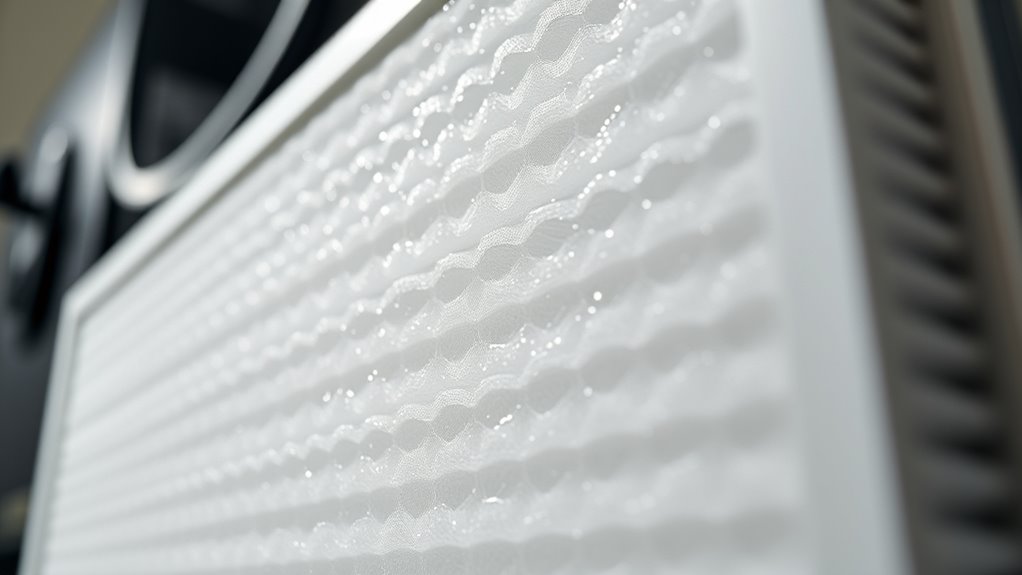
When it comes to air filtration, the HEPA 14 filter stands out as the gold standard, boasting an impressive capability to capture 99.995% of particles as small as 0.1 microns.
This level of filtration is vital in environments like operating rooms and laboratories, where maintaining the highest air quality is essential.
Unlike standard HEPA filters that trap particles down to 0.3 microns, HEPA 14 filters excel at capturing even smaller particles, including some viruses and bacteria.
Their stringent performance criteria make them ideal for settings that demand ultra-clean air, greatly reducing airborne contaminants.
As air purification technology advances, HEPA 14 filters are increasingly integrated into systems designed to meet the growing need for improved indoor air quality.
The Impact of HEPA Filters on Indoor Air Quality

HEPA filters considerably enhance indoor air quality by capturing at least 99.97% of airborne particles as small as 0.3 micrometers.
HEPA filters significantly improve indoor air quality by capturing 99.97% of airborne particles as small as 0.3 micrometers.
This remarkable filtration capability not only reduces allergens but also improves overall respiratory health.
Here’s how HEPA filters make a difference:
- Remove airborne allergens like pollen and pet dander.
- Reduce particulate matter levels by 12-68% in various indoor settings.
- Minimize exposure to mold spores, which can trigger respiratory issues.
- Create a healthier environment, lowering the risk of asthma and allergies.
- Additionally, green technologies that incorporate advanced filtration systems can further contribute to sustainable living practices.
Maintenance and Replacement of HEPA Filters
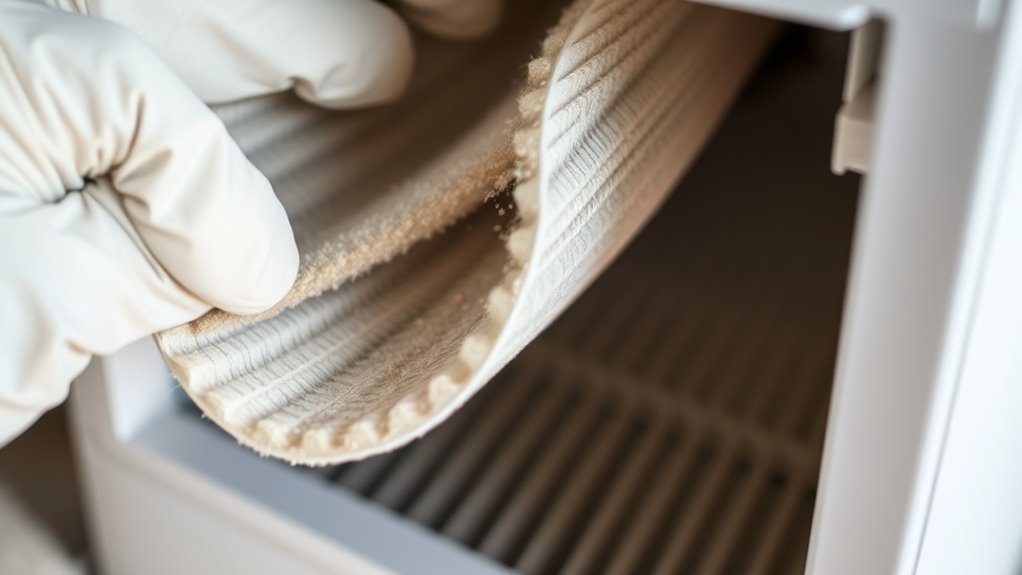
To maintain ideal air purification, regular upkeep of HEPA filters is crucial. You should check for dirt accumulation and clean or replace them according to the manufacturer’s guidelines. Typically, HEPA filters last between 6 months to 2 years, depending on usage and air quality. Replace filters when they appear dirty or airflow decreases considerably.
| Maintenance Task | Frequency |
|---|---|
| Check for dirt | Monthly |
| Clean filter (if washable) | Every 3 months |
| Replace filter | 6 months – 2 years |
| Inspect smart indicators | Monthly |
Neglecting maintenance can hinder air purification performance, allowing harmful particles to affect your indoor air quality. Stay proactive to promote a healthier environment!
Choosing the Right HEPA Air Filter Machine

How do you choose the right HEPA air filter machine for your needs? Start by ensuring it features genuine HEPA filters, which capture at least 99.97% of particles larger than 0.3 micrometers for effective air purification.
Selecting the right HEPA air filter machine begins with verifying it has genuine HEPA filters for optimal air purification.
Here are some key factors to take into account:
- Clean Air Delivery Rate (CADR): Look for a higher CADR for better performance based on your room size.
- Activated Carbon Filters: These help eliminate volatile organic compounds (VOCs) and odors.
- Noise Level: Quieter models are ideal for bedrooms or quiet spaces.
- Regular Maintenance: Don’t forget to replace HEPA filters on time to maintain peak performance.
Frequently Asked Questions
Do HEPA Filters Really Clean the Air?
Yes, HEPA filters really clean the air. They capture at least 99.97% of particles larger than 0.3 micrometers, which means they effectively remove dust, pollen, and pet dander from your indoor environment.
When you use an air purifier with a genuine HEPA filter, you can greatly improve air quality.
Just remember, while they’re great for larger particles, they mightn’t catch the smallest ones, so consider your specific needs.
What Is the Benefit of a HEPA Filter in an Air Purifier?
Using a HEPA filter in your air purifier can greatly enhance your indoor air quality.
You’ll notice fewer allergens, dust, and pollutants in the air, which can help reduce allergy symptoms and improve respiratory health.
By capturing at least 99.97% of airborne particles larger than 0.3 micrometers, these filters create a cleaner environment.
If you have asthma or sensitivities, a HEPA filter’s benefits can be especially noticeable in your day-to-day well-being.
What Is the Working Principle of HEPA Filter?
Imagine a fortress made of tightly woven threads, standing guard against invisible invaders. That’s your HEPA filter at work.
It captures airborne particles through various mechanisms—larger ones collide and get stuck, while smaller ones dance randomly until they adhere to the fibers.
As air flows through, the filter effectively traps 99.97% of particles at 0.3 micrometers, ensuring you breathe cleaner air.
It’s your shield against harmful pollutants lurking in your space.
How Does a HEPA Air Filter Work?
A HEPA air filter works by trapping airborne particles as air passes through its dense mat of fibers.
You’ll notice that it captures at least 99.97% of particles down to 0.3 micrometers in size.
As air flows through, mechanisms like impaction and interception help snag contaminants.
This design allows for multiple air passes, boosting its effectiveness.
Keep in mind, though, that some smaller particles might still slip through.
Conclusion
To sum up, investing in a HEPA filter isn’t just a choice; it’s a game-changer for your indoor air quality. By understanding how these powerful filters work and choosing the right one for your needs, you can breathe easy, knowing you’re creating a healthier home environment. Don’t underestimate the impact of clean air—it’s like turning your living space into a sanctuary! Take the leap, and experience the difference that pristine air can make in your life.
